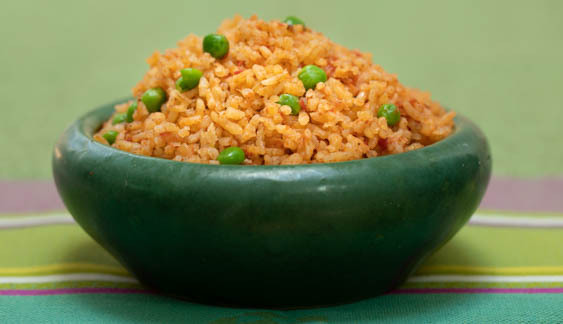Mexican Red Rice (Arroz Rojo)

introduction
Back in the 1500s, tomatoes and rice participated in a little foreign exchange program. Tomatoes found their way from Mexico or Central America to Italy or Spain and rice landed in Mexico through Spanish colonization. There was something interesting about the rice brought from Spain, however: it was an Asian long-grain variety imported from the Philippines (a Spanish colony), not the short- or medium-grain rice favored for rice cookery in Spain.
Unsurprisingly, the pilaf made with tomatoes and onions that came to be known as Mexican red rice produced a dryish, fluffy rice uniquely suited to long-grain rice cookery. It was sometimes called Spanish red rice, though no such dish exists in Spain.
Ultimately, the take-out and tienda culture brought Mexican red rice to a near-death low. With this recipe we attempt to redress the ills of tomato-tinted converted rice shoveled onto a paper plate next to a splotch of refried beans. We’re certain you’ll agree. It may very well be the best Mexican rice you’ve ever eaten. Fluffy, light, and deeply resonant with homemade chicken stock, the tomato, onion, and garlic that inform its seasonings taste fresh and balanced. Frying the grains in oil before simmering them in stock is the secret to light, airy rice, and the floral aromas that waft from Anson Mills chameleon-grained Carolina Gold as it sizzles gently in oil is nothing short of transporting.
This arroz rojo and the Refried Sea Island Red Peas we developed are an exceptionally delicious pairing.
Cooking Remarks
Experience has taught us if the rice is made with too much tomato-onion purée, the grains wind up wet and lifeless. If made with too little purée (and if no compensation is made by supplementing with chicken broth), the grains are prone to scorching and will cook up too dry. The best way to measure the purée is by weight on a digital scale, as the air incorporated during blending makes it all but impossible to get an accurate volume.
equipment mise en place
For this recipe, you will need a digital kitchen scale, a large fine-mesh strainer, a medium heatproof bowl, a blender, and a heavy-bottomed large saucepan.
-
-
10.5ounces (1½ cups) Anson Mills Carolina Gold Rice
-
8ounces ripe tomato, cored and cut into rough 1-inch chunks
-
6ounces (about ½ large) white onion, cut into rough 1-inch chunks
-
1medium jalapeño chile, stem and seeds removed, roughly chopped
-
3medium garlic cloves, peeled and halved, germ removed, if present
-
¼cup avocado oil
-
Fine sea salt and ground black pepper
-
1cup Rich Homemade Chicken Stock, plus additional if needed
-
1small Turkish bay leaf
-
3ounces (¾ cup) frozen peas, thawed and patted dry on paper towels
-
-
Place the rice in a large fine-mesh strainer and rinse it under cool running water, gently stirring it about, until the water runs clear. Shake the strainer to remove excess water, set the strainer over a heatproof medium bowl, and let the rice drain for about 10 minutes.
-
Meanwhile, in a blender, combine the tomato, onion, jalapeño and garlic. Purée until the mixture is completely smooth, about 45 seconds; it will turn frothy and light pink. Pour the purée into a bowl set on a digital scale; you should have about 14 ounces. If you have considerably more, spoon out the excess; if you are shy, make up the difference with chicken broth in step 4.
-
In a heavy-bottomed large saucepan, warm the oil over medium-high heat until shimmering. Add the rice, then discard any water in the bowl, return the strainer to the bowl, and set them near the stove top. Cook the rice, stirring frequently, until the grains are pale gold in color, about 5 minutes. Immediately drain the rice in the strainer and return the pan to the turned-off burner.
-
Add the tomato-onion purée to the pan, along with the bay leaf, 1 teaspoon salt, and ½ teaspoon pepper. Bring to a simmer over medium-high, stirring frequently, and cook until the purée is no longer frothy and the alliums lose their raw and pungent aroma. Pour in the stock and return to a simmer, then add the rice and stir to combine; the grains should still be hot, so the mixture will quickly return to a simmer. Cover, turn down the heat to low, and cook until the rice has absorbed the liquid, about 13 minutes. Remove from the heat and let stand, covered, for 10 minutes.
-
Add the peas to the pot and fluff the rice with a fork or wooden spoon, incorporating the peas. Remove and discard the bay leaf.